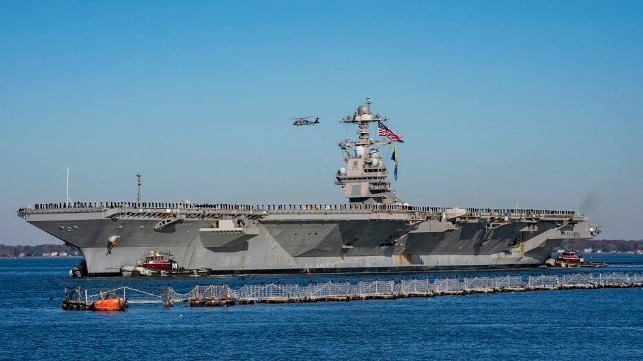Carrier USS Ford Completes Brief First Deployment

The first-in-class aircraft carrier USS Gerald R. Ford has returned to Naval Station Norfolk after finishing a 52-day "service-retained" deployment, her first since her delivery in 2017.
During her deployment, the carrier trained with warships from multiple allied navies, and she called in Halifax, Nova Scotia and Plymouth, UK. She sailed a total of about 9,300 nautical miles.
For her first deployment, Ford remained under the control of the U.S. Navy, reflecting her developmental status. Ford's first deployment was a long time coming. Her launch and recovery gear and her weapons elevators are all electromagnetic, a technological departure from the previous Nimitz-class carriers, and post-delivery installation and commissioning work took more than four years.
Her electromagnetically-actuated weapons elevators were among the most difficult systems to complete, and the last was finished at the end of 2021. Now that they are operational, they allow Ford's crew to move munitions from the magazine to the flight deck at a much faster clip, which is essential to generating sorties.
Assets belonging to the navies of Canada, Denmark, Spain, France, Germany, the Netherlands, and Sweden escorted Ford and conducted exercises with her during her voyage.
“We sailed with our Allies and partners and trained together, tirelessly, day and night, and we are stronger for it,” said Capt. Paul Lanzilotta, commanding officer of USS Ford. “We set the stage for operating with Ford-class technologies in a deployed environment. We completed more than 1,250 sorties, expended 78.3 tons of ordnance, and completed 13 underway replenishments – and we accomplished this because of what Ford-class aircraft carriers bring to the fight.”
Ford was designed to generate 160 sorties in a 12 hour fly day, or 270 sorties in 24 hours at surge capacity. Her sortie generation over the span of her deployment is equal to about eight days at the design rate; the Pentagon's Director of Operational Testing and Evaluation (DOT&E) has concluded that it is unlikely that the carrier will be able to reach the 160-per-day mark.
"The target [rate] threshold is well above achieved historical rates and based on unrealistic assumptions, including fair weather and unlimited visibility, along with the expectation that aircraft emergencies, failures of shipboard equipment, ship maneuvers, and manning shortfalls will not negatively affect flight operations," DOT&E concluded in its FY2021 annual report. "Poor reliability of key systems that support sortie generation on CVN-78 could cause a cascading series of delays."
